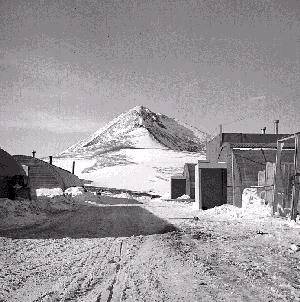

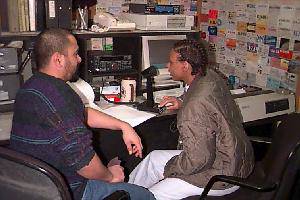
A note from the end at the beginning... My motto this past month was "I'll shoot anybody, anywhere, anytime." --With my ecamera. So I have been running around to a lot of places in town that I have never been to before, taking pictures for others to send home with their email. One entire day was a session that involved over fourty shots of the Navy folks for a spread in their magazine _All Hands_. A spinoff from all this photographic activity is -- there are a lot of ephotos attached to this letter, for those of you who read it on the WWWeb, that I have not discussed in the text, vignettes from around town. Next week I have an appointment to take El Gato to the greenhouse.
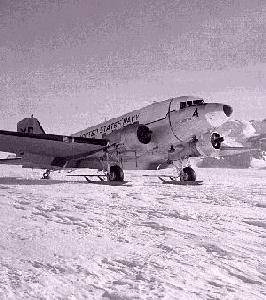
A newly published book by Commander James Edgar Waldron, can be found at The International Antarctic Centre in New Zealand.
"Read with me as I journey through those distant skies where many might have wished to go, but few were able to make the sacrifice of time and energy necessary. I was never disenchanted with my Antarctic experience, though it seemed at times like a time without end."
In 1957, while I was reading about Operation Deepfreeze, and
spending
part of that summer at the Boy Scout Jamboree in Valley Forge, Waldron
was flying the R4D to McMurdo. What today takes two days of flying took
him five. I think he had the better deal, he got to see some of the
islands
I fly right over. The kids at Valley Forge talked about how George
Washington
wintered there and a couple of years later combined the deepfreeze idea
with the jamboree and camped for two nights on the lawn of the church
where
our group met. Now I am where Waldron was wondering who takes my place
at Valley Forge. 

Down the hall from the N.O.C., beyond the F.O.C.C., across from Herc Ops, is The Head. There is a sign on the door advising of the nonsexical nature of this head and advising prospective entrants to announce their intentions before entering. Inside there is lots of polished copper piping. What caught my eye, after looking at it from time to time over the past three winters, is the pattern of the drain holes in the bottom of the porcelain receptical. A well defined and symetrical Star of David is right there where the puddle pools; I don't quite know what to make of it. I am amused and I am outraged. And so the quest is on to find if intolerance or equality will rule the day.
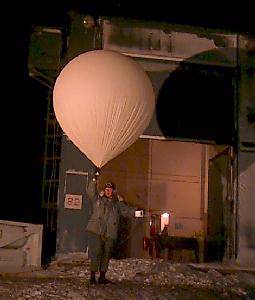
I hope you will find the time to write during your holiday, I always like to have letters telling about brooks and birds and warm sunny places. Right now I am thinking about what I will do on my next holiday. In the meantime my kite is nailed to the ceiling over my bed and his string is put away with the coffee beans where El Gato will not find it. (El Gato hates coffee, even when there is mostly cream in it.) Speaking of cream in coffee, I have figured out that the case of evaporated milk I had sent in from Christchurch (Thanks again Janet) will not last until October at the rate I'm using it so I've started thining it --half and half-- with Baileys.
Birthday Dinner Revisited. It was a great time. Not grand, but
great.
I would reserve "grand" for meals served at the table not the buffet
line,
for meals accompanied by linen not paper napkins, for places set with
silver
and crystal (at the least glass) not plastic (I bring my own linen and
silver and crystal, just to preserve a semblance of tradition); but the
food was the best we have to offer our selfs and one of my peers
dressed
and acting the role of wine steward went from table to table opening
and
pouring. Wine and champagne were paid for out of some pocket other than
mine (tho I did bring two full bottles to table I went away with four
halfs).
I helped set up. It is the best we can do for each other. 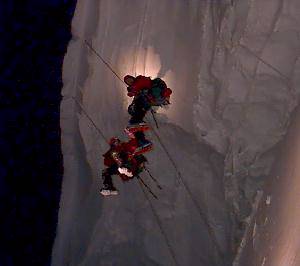
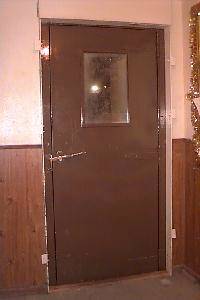
It has got sort of hectic here with a few problem breakdowns.
Another
thing
about the old days compared to now is that then when something broke
we,
me or someone else, fixed it. Maybe we had to go so far as to scrounge
some parts over at the warehouse. But we fixed it and if it was really
important it might rate a line or two in a weekly report. Today when
something
breaks, especially if its really important, the forst thing you do is
file
a trouble call. And maybe even an ERR form. I don't know what ERR means
but if you want to get something fixed, even if you are ultimately the
one who will do the fixin', you have to file the ERR form; the trouble
call does not necessarily get the fixing process underway. Like getting
a lightbulb changed--you have no doubt heard all the Jewish-Polish-New
York- psychologist-light bulb changing jokes you ever want to hear but
I want to report from the front lines that you have not heard anything
til you hear how many NSF-ASA-OAE persons it takes to change a light
bulb
in Antarctica. Let me count them. 
1. The person who notices the bulb is out makes the trouble call to
2. The trouble desk operator who records the information and passes it to
3. The work-order dispatcher who schedules the job and passes it to
4. One or more work centers who assign the appropriate specialist.
(Nothing
screws up this process more than some of them fancy new power saving
(at
way extra cost) screw-in immitation incandescent florescent bulbs. They
send out a florescent bulb changer (these folks have special high
intensity
training for handling the hazardous materials fancy florescent bulbs
are
made of) only to find that a screw base incandescent blub changer is
required
as well. That generally causes a days delay. Some times, in the case of
recessed overhead fixtures, additional support is required from a
ceiling
tile specialist. Additionally, if there are any sprinkler heads within
harms way, then a fire alarm technician, plumber, will be
required.) 
5. Assuming a best case scenario, one bulb changing specialist will call
6. The parts warehouse to request a bulb be drawn from stock and
7. Arrange with an administrative assistant to be sure the work center truck, usually shared by several specialists, will be available; then if the location of the bulb to be changed is in a locked office the bulb changer will have to arrange for accompanyment of at least one supervisor level person (us peons are not to be trusted) but staying with the best case scenario our specialist takes truck and bulb and ladder to place and changes bulb. But its not over yet. The bad bulb is to be placed in the proper waste receptical. This often requires the assistance of
8. A waste management specialist. After which the bulb changer returns truck and ladder to work center and services the original job request back to the scheduler and makes a matching entry on their weekly timesheet.
So there you have it. Best case light bulb changing expedition employs eight people over a typical period of two days maybe three. And all that is predicated upon the bulb being in stock. It will take at least the first six of those folks just to tell you the computer says there are none on the shelf. (What you need a Human for is to learn the bulbs you are searching for can be found in one of the Closed-For-The-Winter buildings...)
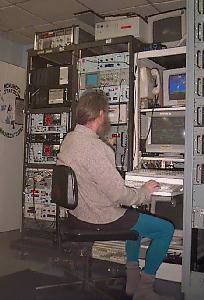
Work continues on supporting the impending third (or fourth) attempt for the launch, with a Pegasus booster, of the Total Ozone Mapping Spectrometer satellite. This is one of the projects that has occupied a large part of my time for the past three years. We have reserved Hut-10 for a dinner on 28th June--the launch is to be on the 29th-- but will of necessity be unable to announce until after the dinner whether it is to was a toast to long awaited accomplishment or the third annual We're Tired Of Waiting For Launch Lunch. Given the range of possibilities it could turn out to be marshmallow roast if the Range Safety Officer presses the Big Red Button again.
Pegasus is a disposable launch vehicle composed mostly of graphite
and
glue (high tech glue of course, not your run of the mill carpenter's
glue)
which is dropped from under the wing of a specially built L-1011
aircraft
that operates out of Vandenburg Air Force Base in southern California.
Launchs from this western space port are polar orbiting, retrograde
orbits,
and the first ground station to draw a bead on the bird is McMurdo. The
initial orbital data  collected here is relayed through Internet and NASA net circuits to the
tracking station at Thule Greenland where commands may be sent to the
satellite
to correct its orbit. McMurdo will see the bird for the next couple of
orbits to continue to provide this feedback.
collected here is relayed through Internet and NASA net circuits to the
tracking station at Thule Greenland where commands may be sent to the
satellite
to correct its orbit. McMurdo will see the bird for the next couple of
orbits to continue to provide this feedback.
Pretty important and mission critical operation so they tell me but all things considered rather kludged together and poorly funded. But fun! Keeps me out of mischief and makes for excellent subject matter as well as providing an excuse to ask for occasional help. There is more detail on the Pegasus project, lots to read and see at several NASA pages on the net.
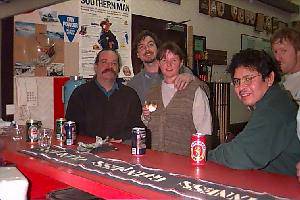
Contrasted with McMurdo's two hundred and some winter-over population Scott Base, run by the New Zealand Antarctic Programme, has a staff of ten. They live in a cluster of modules connected by enclosed passageways at the edge of the Ross Ice Shelf along the road from McMurdo to Willy Field. More akin to Palmer in size but like McMurdo in scope and programme, Scott Base is for McMurdans a place to visit the neighbors, go out for dinner, hobnob at the pub. The bar at Scott Base has an atmosphere different than that at the Erebus or Southern Light at McMurdo. It starts I think at Scott with that they will take U.S. dollars while at McMurdo Kiwi dollars are not acceptable.
On Thursday's when the Scott Base bar is open to the McMurdo
community
the Kiwis are frequently out numbered by the Yanks. El Gato went along
to have a go at Twiddles' Cat Box, which she visited last about this
time
a year ago, and then got quite lost hunting it down. The catbox use to
be hard by the bus stop door, just down from the pub, but last summer,
we learned, someone who was obviously a dog person took it away. It
turns
out that Twiddles has also disappeared. Well! what can you expect? was
El Gato's response to this disturbing news; --Whence goeth the catbox,
so goeth the cat. 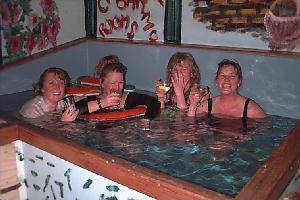
Another thing about Scott Base akin to Palmer is that the Kiwis enjoy the use of a hot tub. It is about the same size as the one I fondly remember at Palmer but rectangular and within a small outbuilding. And they don't have the sea as nearby for contrast (actually the sea is near but under the ice) nor are there drifts of soft fresh snow to roll in. But the water is hot...
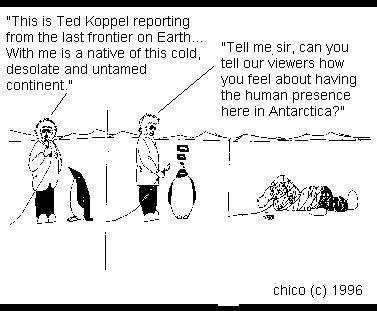
In report language last year, the Senate Appropriations Committee expressed concern "about the ability for NSF to continue to fund a U.S. permanent presence [in Antarctica] given severe budget constraints." It directed the National Science and Technology Council (NSTC), the cabinet-level coordinating body for federal science policies, to "examine the validity" of current U.S. Antarctic policy (see FYI #131, 1995.)
The U.S. has maintained an active presence in the Antarctic for more
than thirty years. The freedom of the U.S. and other countries to
perform
research there, as well as a decision-making mechanism for potential
conflicts,
was codified in the 1959 Antarctic Treaty. Currently, the U.S.
Antarctic
Program (USAP) is managed by the NSF as a single integrated program
under
a 1982 Presidential directive to maintain year-round occupation of a
South
Pole station and two coastal stations. The program deploys about 2,500
personnel to the area each year to perform research for a number of
federal
agencies, including NSF, NASA, NOAA, DOE, and the USGS. The annual cost
is  about $196
million a year, including research, infrastructure, logistics and
operational
support, three research stations and two research vessels. In the near
future, budget pressures will be exacerbated by the need to rebuild or
replace the Amundsen-Scott South Pole Station at a cost that might
range
from $100-200 million.
about $196
million a year, including research, infrastructure, logistics and
operational
support, three research stations and two research vessels. In the near
future, budget pressures will be exacerbated by the need to rebuild or
replace the Amundsen-Scott South Pole Station at a cost that might
range
from $100-200 million.
In a 67-page report released in April, the NSTC summarizes the history of the U.S. program and finds that "at the current level of investment, the USAP is cost effective in advancing American scientific and geopolitical objectives and, from a science perspective, supports the continuation of three stations with year- round presence." The full text of the report is currently available on NSF's Home Page under "News of Interest."
The Antarctic Artists and Writers Program
"David Rosenthal first came to Antarctica as a General Assistant on
a year contract in 1989. He returned as a National Science Foundation
artist
for the first time during summer 93/94 and returned as Artist in
Residence
this winter. 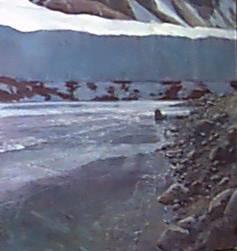
"Dave started painting in Maine in 1974. Now a resident of Alaska, he has a special interest in painting wintry environments. He has traveled in the Arctic with the Artist in the Schools Program in Alaska and traveled with the Coast Guard Artists Program in the Arctic north of Greenland and Spitsbergen.
"To obtain the position of Artist or Writer in Residence, a person must be prominent in their chosen field with a substantial record of critical recognition. The National Science Foundation does not attempt to judge the quality of the artist's or writer's work but rather whether they can reach a "significant audience." The position does not include a salary or materials but travel and living expenses are covered for the time of the Antarctic stay.
"At mid-century half of Antarctica still had not been seen. Since
then,
scientists from the United States and other nations have been engaged
in
research aimed at knowing Antarctica and its relationship with the rest
of the planet. Under the Antarctic Treaty, which reserves this large
region
for peaceful purposes, scientific inquiry has been the overwhelming
focus
of the human presence. Investigations have been made in the disciplines
of astrophysics, the atmospheric, earth and ocean sciences, biology,
and
human psychology and physiology. The benefit of this approach has been
greater understanding of Antarctica and present and past global
environments. 
"But what of the aesthetic aspects of this southernmost continent? What is Antarctica like? What is Antarctica's contribution to our culture and heritage? And what is it like to be here? Science is not equipped to answer these questions completely.
"Recognizing this, the National Science Foundation established the Antarctica Artist's and Writer's Program. This program enables artists, writers, photographers, poets, and other scholars in the humanities to participate in the United States Antarctic Program, and to bring back to the world their impressions and images. The work of these artist complements that of the scientists, leading to a more complete understanding of this frozen land at the edge of the world."
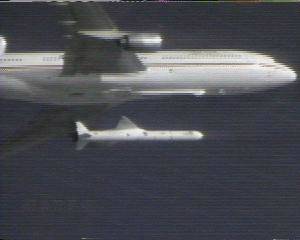
The official news has been announced! The 100 person population cap is for ASA only next winter and it is a one winter let's-see-what- happens "proposal" at this point, perhaps put forth by some rabid manager making a budget cutting impression; there will still be 20 NSFA and it remains unclear what about MWR and whether the new subcontract for galley and janitorial services comes under the 100 person cap. But you can be sure that food services will suffer; perhaps that is presumptuous to prejudge but it is also prevailing opinion and it probly would not matter how good the services might be, they will be perceived as worse just cos of the circumstances.
The galley folks are being offered a fixed bonus at a rate less than what most of them are making now and a cut in base pay on top of that to sign on with the new contractor. A clever facad to get rid of the folks who know how to run the place.
And this rumor is true as well: everyone will live two to a room in Building 155 next winter; except of course the NSF manager, the ASA manager, and the OIC. All the dorms will be closed down cold, to save fuel (and so that all the plumbers and painters will have something to do next summer when they warm up and the pipes leak and the walls peel.) This is of course a proposal also and there is the possibility, as explained by the present manager, that a last minute increase in population could require that one dorm be left open. It was left unstated that a last minute increase in population could, just as well, instead, require some folks to live three to a room in 155.
Looks like w/o97 is going to be a good time to be not
here. 
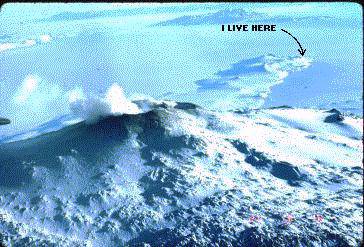
Mount Erebus is in the news, if for no other reason than something to write about. What would happen if she blew her top? Which way would the lava flow. There is a neat three dimensional map that might help envision the possibilities. Aside from a deluge of lava bombs, and this place looks like that has happened at least once in geologic history, I doubt we'd have much problem with lava. The ash fall could get pretty messy and the penguins on the north coast might be most unhappy. In the summer we can often see a plume of steam rising from the summit and the lava lake inside the crater is convecting but the earth is mostly quiet, except for when my neighbors down the hall crank up their sound blaster on saturday night. I don't hear the music really but my floor and window keep time with the beat.
Stay Gold, Love, me

Back to ajo
Copyright (c) 2002 A.J.Oxton The
Cat Drag'd Inn ![]()